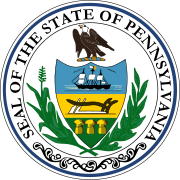Class I U.S. Senate election in Pennsylvania
The 1793 United States Senate special election in Pennsylvania was held on February 28, 1793. Albert Gallatin was elected by the Pennsylvania General Assembly to the United States Senate. [1]
| Elections in Pennsylvania |
|---|
 |
The 1793 United States Senate special election in Pennsylvania was held on February 28, 1793. Albert Gallatin was elected by the Pennsylvania General Assembly to the United States Senate. [1]
Due to the initial staggering of United States Senate terms, the Class 1 seat held by William Maclay became vacant upon the expiration of Maclay's term on March 4, 1791. He had served since March 4, 1789, after being elected by the State Assembly in 1788. The election of a new Senator to succeed Maclay in 1791 was delayed due to a disagreement on the procedure to be followed in the election. The seat remained vacant until Albert Gallatin's election to the seat during this election. [2]
Upon agreement between the two houses of the Pennsylvania General Assembly, the House of Representatives and the Senate, regarding the procedure to elect a new Senator, an election was finally held on February 28, 1793. The results of the vote of both houses combined are as follows:
| Party | Candidate | Votes | % | |
|---|---|---|---|---|
| Anti-Administration | Albert Gallatin | 45 | 51.72 | |
| Pro-Administration | Henry Miller | 35 | 40.23 | |
| Pro-Administration | Arthur St. Clair | 1 | 1.15 | |
| Pro-Administration | William Irvine | 1 | 1.15 | |
| N/A | Not voting | 5 | 5.75 | |
| Totals | 87 | 100.00% | ||
On February 28, 1794, the United States Senate determined that Gallatin did not satisfy the citizenship requirement to serve in the Senate. He was subsequently removed from office. He later went on to serve in the United States House of Representatives. Gallatin was replaced in the Senate by another special election in the State Assembly in 1794. [3]

The 2nd United States Congress, consisting of the United States Senate and the United States House of Representatives, met at Congress Hall in Philadelphia, Pennsylvania, from March 4, 1791, to March 4, 1793, during the third and fourth years of George Washington's presidency. The apportionment of seats in the House of Representatives was based on the provisions of Article I, Section 2, Clause 3 of the United States Constitution. Additional House seats were assigned to the two new states of Vermont and Kentucky. Both chambers had a Pro-Administration majority.
The United States Senate elections of 1790 and 1791 were the second series of elections of senators in the United States. In these elections, terms were up for the nine senators in Class 1. As of these elections, formal organized political parties had yet to form in the United States, but two political factions were present: The coalition of senators who supported President George Washington's administration were known as the Pro-Administration Party, and the senators against him as the Anti-Administration Party.
The United States Senate elections of 1856 and 1857 were elections which had the young Republican Party assume its position as one of the United States's two main political parties. The Whigs and Free Soilers were gone by the time the next Congress began.
The United States Senate elections of 1844 and 1845 were elections which, coinciding with James K. Polk's election, had the Democratic Party retake control of the United States Senate, gaining a net total of eleven seats from the Whigs.

The United States Senate elections of 1890 and 1891 were elections in which the Republican Party lost four seats in the United States Senate, though still retaining a slim majority. That majority was increased, however, upon the admission of two more states with Republican senators.
The United States Senate elections of 1840 and 1841 were elections which, corresponding with their party's success in the 1840 presidential election, had the Whig Party take control of the United States Senate.
The United States Senate elections of 1792 and 1793 were elections of United States Senators that coincided with President George Washington's unanimous re-election. In these elections, terms were up for the ten senators in class 2.
The United States Senate elections of 1794 and 1795 were elections that had the formation of organized political parties in the United States, with the Federalist Party emerging from the Pro Administration coalition, and the Democratic-Republican Party emerging from the Anti-Administration coalition.

The United States Senate elections of 1860 and 1861 were elections corresponding with Abraham Lincoln's election to the presidency. The nascent Republican Party increased their Senate seats in the regular elections, and after southern Democrats withdrew to join the Confederacy, Republicans gained control of the United States Senate. To establish a quorum with fewer members, a lower total seat number was taken into account.

The United States Senate elections of 1788 and 1789 were the first elections for the United States Senate, which coincided with the election of President George Washington. As of this election, formal organized political parties had yet to form in the United States, but two political factions were present: The coalition of senators who supported George Washington's administration were known as "Pro-Administration", and the senators against him as "Anti-Administration".

The 1788 United States Senate election in Pennsylvania, held on September 30, 1788, was the first United States Senate election held in Pennsylvania. The Pennsylvania General Assembly, consisting of the House of Representatives and the Senate, elected Pennsylvania's first two United States Senators, William Maclay and Robert Morris.

The 1794 United States Senate special election in Pennsylvania was held on March 31, 1794. James Ross was elected by the Pennsylvania General Assembly to the United States Senate.

The 1797 United States Senate election in Pennsylvania was held on February 16, 1797. Incumbent James Ross was re-elected by the Pennsylvania General Assembly to the United States Senate.

The 1802 United States Senate election in Pennsylvania was held on December 14, 1802. Samuel Maclay was elected by the Pennsylvania General Assembly to the United States Senate.

The 1808 United States Senate election in Pennsylvania was held on December 13, 1808. Michael Leib was elected by the Pennsylvania General Assembly to the United States Senate.

The 1840 United States Senate election in Pennsylvania was held on January 14, 1840, after the regularly scheduled election in December 1838 was postponed due to the Buckshot War. Daniel Sturgeon was elected by the Pennsylvania General Assembly to the United States Senate.

The 1795 United States Senate election in Pennsylvania was held on February 26, 1795. William Bingham was elected by the Pennsylvania General Assembly to the United States Senate.

The 1856 United States Senate election in Pennsylvania was held on January 14, 1856. William Bigler was elected by the Pennsylvania General Assembly to the United States Senate.

In 1791, the Pennsylvania legislature failed to elect a U.S. Senator due to a disagreement on procedure. The seat would remain vacant until 1793.